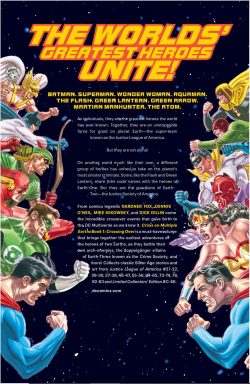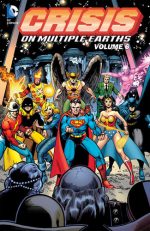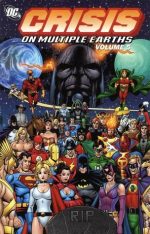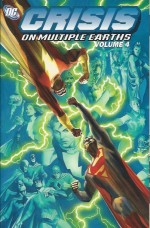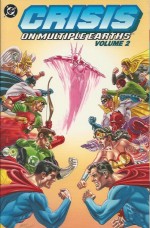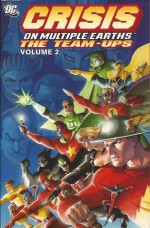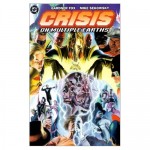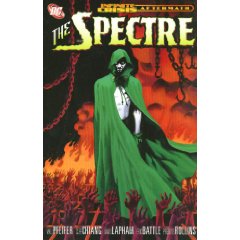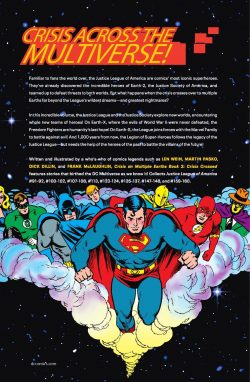
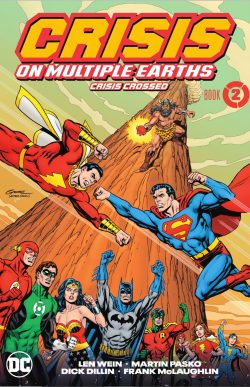
By Mike Friedrich, Len Wein, Martin Pasko, E. Nelson Bridwell, Cary Bates, Elliot S! Maggin, Paul Levitz, Gerry Conway, Dick Dillin, Frank McLaughlin, Joe Giella, Dick Giordano & various (DC Comics)
ISBN: 978-1-77951-342-7 (TPB/Digital)
Win’s Christmas Gift Recommendation: utterly Unmissable Entertainment… 9/10
As I’ve incessantly mentioned, I was one of the “Baby Boomer” crowd growing up with Julie Schwartz, Gardner Fox and John Broome’s tantalisingly slow reintroduction of Golden Age superheroes during the halcyon, eternal summery days of the early 1960s. To me, those fascinating counterpart crusaders from Earth-Two weren’t vague and distant memories rubber-stamped by parents or older brothers – they were cool, fascinating and enigmatically new. And for some reason the “proper” heroes of Earth-One held them in high regard and treated them with obvious deference…
The transcendent wonderment began, naturally enough, in The Flash; pioneering trendsetter of the Silver Age Revolution. After successfully ushering in the triumphant return of the superhero concept, the Scarlet Speedster – with Fox & Broome writing – set an unbelievably high standard for costumed adventure in sharp, witty tales of science and imagination, always illustrated with captivating style and clean simplicity by Carmine Infantino.
The epochal epic that literally changed the scope of American comics forever was Fox’s ‘Flash of Two Worlds’ (Flash #123 September 1961, reprinted in many places, but not here): introducing to an emerging continuity the concept of alternate Earths and, by extension, the multiversal structure of the future DCU as well as all the succeeding cosmos-shaking yearly “Crisis” sagas that grew from it.
…And, where DC led, others followed…
Received with tumultuous acclaim, the concept was revisited months later in Flash #129 which also teasingly reintroduced evergreen stalwarts – Wonder Woman, The Atom, Hawkman, Green Lantern, Doctor Mid-Nite and Black Canary: venerable members of the fabled Justice Society of America. Clearly Editor Schwartz had something in mind…
That tale directly led into the veteran team’s first meeting with the Justice League of America and the start of an annual tradition. When ‘Flash of Two Worlds’ brought us the notion of Infinite Earths and multiple iterations of costumed crusaders, fan pressure had begun almost instantly to agitate for the return of the Greats of the “Golden Age”. Editorial powers-that-be were hesitant, fearing too many heroes would be silly and unmanageable, or worse yet, put readers off. If they could see us now…
These innovative adventures generated an avalanche of popular and critical approval (big sales figures, too) so inevitably the trans-dimensional tests led to the ultimate team-up in the summer of 1963. This second gloriously enthralling volume celebrating Infinite Diversity in Infinite Costumes gathers more summer double-headers starring the JLA & JSA and includes a number of revivals and outreach tam-ups designed to set young hearts racing and pulses pounding. The alliances encompass Justice League of America # 91-2, 100-102, 107-108, 113, 123-124, 135-137, 147-148 and 159-160: stunning superhero wonderments which never fail to astound and delight. Also on offer are Len Wein’s context-conveying Foreword ‘Too Much of a Good Thing?’ revealing how the landmark anniversary team-up he scripted came about, and colourist Carl Gafford’s Introduction discussing the incredible achievements of the series’ illustrators such as the criminally underappreciated Dick Dillin who pencilled every story here… usually with his long-term inker Frank McLaughlin, although there are few other old friends here.
In terms of narrative, the writing – by a formidable cohort of writers nurtured and mentored by “Julie” – consists of nothing more and nothing less than bunches of beguiling mystery men getting together to deal with extra-extraordinary problems…
From the early 1970s, DC started methodically reintroducing lost and forgotten characters from other companies and pantheons DC had bought out over the years, at last convinced that costumed heroes were not a fad but here to stay. With hindsight, it was all also about sales and the attempted revival of so many super-characters during a period of intense sales rivalry between DC Comics and Marvel was just sound business sense…
The dramas resume with Mike Friedrich, Dillin & inker Joe Giella’s Justice League of America #91 (cover-dated August 1971), the hero-heavy opening chapter of the annual get-together. In ‘Earth… the Monster-Maker!’, the Supermen, Flashes, Green Lanterns, Hawkmen, Atoms and Robins of two separate Realities simultaneously but ineffectually battle an alien boy and his symbiotically-linked “dog” on twin planets a universe apart.
The result is pointless carnage and imminent death until ‘Solomon Grundy… the One and Only!’ gives all concerned a life-saving lesson on togetherness and lateral thinking…
Justice League of America #100 (August 1972) heralded a move away from relevancy and social hot-button topics that had dominated the industry for a number of years and a return to full-on Costumed melodramas, beginning with a colossal 3-team collaboration that also featured almost every hero in then-DC’s pantheon.
‘The Unknown Soldier of Victory!’ saw debuting scripter Len Wein assemble champions of two Earths to facilitate a monumental hunt through time and retrieve forgotten heroes the Seven Soldiers of Victory: not simply out of common decency, but also because the vanished vigilantes held the answer to defeating a criminal mastermind literally holding the world of Earth-Two to ransom.
Inked by Giella & Dick Giordano, the quest continued in ‘The Hand that Shook the World!’ before ending in one adventurer’s gallant final sacrifice in ‘And One of Us Must Die!’…
A year gone by, Justice League of America #107 by Wein, Dillin & Giordano proclaimed ‘Crisis on Earth-X!’ as the opening chapter of another landmark crossover. Following the successful revival of a lost team in their previous get-together, this time the annual shenanigans reintroduced another band of Golden Age warriors – from corporate acquisition Quality Comics and newly rechristened The Freedom Fighters…
It begins when a recreational trip across the dimensional barrier is accidentally sabotaged by android stowaway Red Tornado, depositing Batman, Green Arrow and Elongated Man from Earth-One and Superman, Sandman and Doctor Fate from Earth-Two into another alternate universe – one where the Nazis had won World War II.
Trapped and outnumbered, the seven displaced heroes were rescued by the last liberty-loving champions of a world dominated by fascist super-science and a secret dictator. Joining forces with embattled champions Uncle Sam, The Ray, Doll Man, Phantom Lady, Black Condor and The Human Bomb, the newcomers ended the fascist threat forever in sinister sequel ‘Thirteen Against the Earth!’…
With everybody returned to their home planes, #113 (September/October 1974) proved how desperate times were the for the spandex set as the epic annual collaboration was restricted to a single issue. Nevertheless, ‘The Creature in the Velvet Cage!’ proved to be one of the very best tales as a JLA visiting party to Earth-Two (Batman, Superman, Green Lantern and Elongated Man) share the shame and horror of The Sandman, when his greatest secret is catastrophically revealed.
Years previously, the Master of Dreams had accidentally transformed his sidekick Sandy, the Golden Boy into a ravening silicoid monster during an attempt to modify their crimebusting technology. Dreading a holocaust, Wesley Dodds been compelled to sedate and imprison his best friend for years…
Now after three decades the beast was awake and free, seemingly intent on destroying the world. At least, that’s what Hourman and the Golden Age Flash and Wonder Woman believe] when they join their old comrade on his tragic manhunt…
For the next annual yarn, Cary Bates, Elliot S! Maggin, Dillin & Frank McLaughlin stepped far off the reservation with ‘Where on Earth Am I?’ and ‘Avenging Ghosts of the Justice Society!’ (#123 and 124)….
In Flash #179 (‘The Flash – Fact of Fiction?’: May 1968) Bates & Gardner Fox first took the multiple Earths concept to its illogical conclusion by trapping the Monarch of Motion in “our” Reality of Earth-Prime, where the Sultan of Speed was merely a fictional comic book character.
For this sequel, Bates and co-scripter Maggin revisited the notion, as a story conference in Editor Julie Schwartz’s office leads to the oafish goons playing with the Flash’s hastily-constructed Cosmic Treadmill. Inevitably their meddling sends one of them hurtling between dimensions…
Transformed and empowered by the journey, Bates becomes the most dangerous villain alive, leading Earth-Two criminals The Wizard, Shade, Sportsmaster, Huntress, Icicle and The Gambler in a lethal assault on JSA heroes Robin, Hourman, Wildcat, Wonder Woman, Johnny Thunder and Dr. Mid-Nite.
Maggin, meanwhile, has followed his friend but ended up on Earth-One. Undaunted, he recruits Batman, Black Canary, Aquaman, Hawkman, Green Arrow and Flash to save three imperilled universes, but it takes the Divine Might of the supernal Spectre to truly set everything back to its assigned place and time…
Plotted by E. Nelson Bridwell and scripted by Marty Pasko, 12 months later the get-together attained epic proportions with the inclusion of venerable champions of the recreated Shazam! Universe – imaginatively dubbed Earth-S. It opens with a ‘Crisis in Eternity!’…
One of the most venerated and loved characters in American comics, the original Captain Marvel was created by Bill Parker & C. C. Beck: the best of a wave of costumed titans devised in the wake of Superman’s blockbuster 1938 debut.
Although there were many similarities in the early years, the Fawcett character moved early into fanciful light entertainment and even comedy, whilst as the 1940s progressed the Man of Steel increasingly left whimsy behind in favour of action and drama.
Homeless orphan Billy Batson was chosen to battle injustice by an ancient wizard who bestowed upon him the powers of six gods and heroes. Billy transforms from scrawny boy to brawny (adult) hero by speaking aloud the wizard’s name – an acronym for the legendary patrons Solomon, Hercules, Atlas, Zeus, Achilles and Mercury. At the height of his popularity Captain Marvel was published twice a month and outsold Superman.
However, as tastes and the decade changed, sales slowed and a court case begun by National Comics citing copyright infringement was settled. The Big Red Cheese disappeared – as did many superheroes – becoming merely a fond memory for older fans.
As America lived through another superhero boom-&-bust, the 1970s dawned with a shrinking industry and wide variety of comics genres servicing a base that was increasingly founded on collector/aficionados, not casual or impulse buys. DC needed sales and were prepared to look for them in unusual places: opting to tap into a proven, discriminating fanbase…
After the settlement with Fawcett in 1953, DC secured the rights to Captain Marvel and Family, even though the name itself had been taken up by Marvel Comics (via a circuitous and quirky robotic character published by Carl Burgos and M.F. Publications in 1967). In 1973, riding a wave of nostalgia, DC brought back the entire beloved Fawcett cast and crew in their own kinder, weirder universe. To circumvent an intellectual property clash, they entitled the new comic book Shazam! (With One Magic Word!) the trigger phrase used by most of the many Marvels to transform to and from mortal form, and a word that had entered the American language due to the success of the franchise the first time around…
In Justice League of America #135, the usually stand-alone Shazam heroes meet other costumed champions when antediluvian dictator King Kull (a bestial despot from a pre-human civilisation who held mankind responsible for the extinction of his race) invaded the Wizard’s home on the Rock of Eternity.
From this central point in the Multiverse, Kull intends wiping out humanity on three different Earths and commences by capturing the gods and goddesses who empower Billy and his magical allies Captain Marvel Jr. and Mary Marvel.
Thankfully, fleet Mercury is able to escape, warning Earths-One and Two, even as lesser heroes Bulletman & Bulletgirl, Ibis the Invincible, Spysmasher and Mister Scarlet & Pinky take up the fight without the missing Marvels…
Recruiting an army of super-villains from three worlds, Kull unleashes a plague of unnatural disasters in ‘Crisis on Earth-S!’, unaware that Mercury, Shazam and dim-witted magic-wielder Johnny Thunder are undertaking a devious counterattack to bring the vanished Marvel Family back into action, just in time to avert a cataclysmic ‘Crisis in Tomorrow!’…
The cross-collaboration protocol resurfaces one year later in brace of double-length sagas guest-starring Silver Age DC’s second-most popular superteam…
Once upon a time, a thousand years from now, a band of super-powered kids from many worlds took inspiration from the greatest heroic legend of all time, founding a club of champions. One day those Children of Tomorrow came back in time and invited their inspiration to join them…
Thus began the vast, epic saga of the Legion of Super-Heroes, as first envisioned by writer Otto Binder & artist Al Plastino when the many-handed mob of juvenile universe-savers debuted in Adventure Comics #247 (April 1958), just as the revived superhero genre was gathering an inexorable head of steam in America.
The coalition grew and prospered, becoming a phenomenon generally attributed with birthing organised comics fandom. After years of slavishly remaining a closely-guarded offshoot of Superman’s corner of continuity, the Legion finally crossed over into the broader DCU with this saga wherein Paul Levitz & Martin Pasko united to detail ‘Crisis in the 30th Century!’
It begins when ultimate sorcerer Mordru drags a handful of JLA and JSA-ers (Superman, Batman, Green Lantern, Green Arrow and Black Canary from Earth-One plus the other Green Lantern, Doctor Fate, Power Girl, Flash and Hawkman from E-Two) into the future to replace a band of ensorcelled Legionnaires he has somehow lost contact with…
Mordru’s previous slaves had been tasked with retrieving three arcane artefacts that were in the JLA’s keeping a millennium past, but with the pawns lost, the wizard now expects his new pets to finish the task. Naturally, the ancient heroes have other ideas…
Even after linking up with the lost Legionnaires, the 20th Centurians cannot prevent the return of demonic triumvirate Abnegazar, Rath and Ghast, but happily, their eons in stasis have affected the eldritch horrors’ psychological make-up and their consequent disunity gives the puny humans one shot at saving the universe from a ‘Crisis in Triplicate!’
This monumental melange of metahuman mayhem concludes with another time tempest and more forgotten stars as five legendary warriors are plucked from history by a most malevolent malefactor for the noblest of reasons. They are then pitted against the greatest superheroes of two worlds in ‘Crisis from Yesterday!’ by scripter Gerry Conway and artistic dynamic duo Dillin & McLaughlin.
In his zeal to conquer and plunder, the nefarious Lord of Time has accidentally created an omnipotent super-computer which is counting down to permanently ending the passage of time. Unable to halt or avoid an impending cosmic catastrophe, the temporal terrorist extracts Jon, the Viking Prince, English freebooter Black Pirate, Revolutionary War heroine Miss Liberty, western gunman Jonah Hex and WWI German enemy ace Hans von Hammer: supercharging them with eerie energies and programming them to attack the united Justice League and Society.
The Time Lord’s logic is simple: after suffering a shattering defeat, the teams – fired with determination and righteous fury – will promptly track him down, invade his Palace of Eternity and destroy for him his unstoppable computer. Or at least, the survivors will…
Surprisingly, that convoluted plan seems to work out in ‘Crisis from Tomorrow!’, but only after the chronally kidnapped quintet overcome their perfidious programming and revert to their valiant true selves. Even as the beleaguered superhero teams sacrifice everything to thwart the Lord of Time, the time-lost warriors prove their mettle against the errant computer…
This staggering panoply of multi-manned calamities and alternate Armageddons is rounded off with an instructive contextual lecture in John Wells’ Afterword ‘Those Were the Days’, augmented by all the rousing front covers by Neal Adams, Giordano, Nick Cardy, Ernie Chan, Frank Giacoia, McLaughlin, Rich F. Buckler, Jack Abel & Dillin: supported by full creator biographies and a ‘Cover Gallery’ from Alex Ross, featuring his painted delights from earlier collected editions.
These tales won’t suit everybody, and I’m as aware as any that in terms of the “super-powered” genre, the work here can be boiled down to bunches of heroes formulaically getting together to deal with extra-extraordinary problems.
Thankfully, I don’t have to be mature in my off-hours and for those who love costume heroes, crave cunningly constructed modern mythologies and actually care about fun, this is simply a grand parade of straightforward action, great causes and momentous victories.
…And since I wouldn’t have it any other way, why should you?
© 1971, 1972, 1973, 1974, 1975, 1976, 1977, 1978, 2021 DC Comics. All Rights Reserved.

